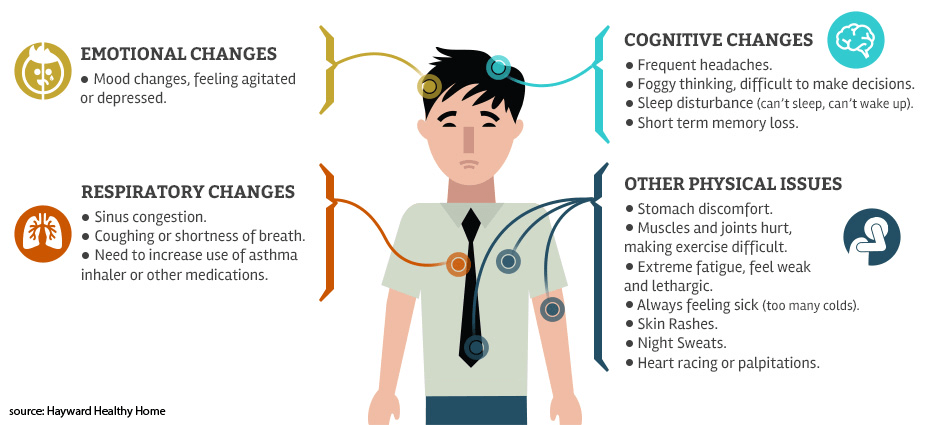A Healthy Home
Your home should be a safe place for you and your family. It should be free from worry about unhealthy external and internal environments, and a place for you to grow and foster your well-being.
Unfortunately, homes aren’t always healthy places to gather, and you may not even realize yours isn’t.
Why Air Quality is Important
We all know how vital it is to breath fresh, clean air when it comes to our health, and the air your home breaths should be equally as healthy. The air your home breathes, is the air you breathe.
So where is your home’s air coming from? Good question.
An unhealthy home will be pulling air from wherever it can. It will find cracks and holes in the house, and could be drawing air from dusty, moist or damp places. Of course, where there is moisture, there could be mould. Perhaps your home is pulling air from directly outside, which should be good, right? With the exhaust from traffic and the wildfires and smoke that have swept through and around our communities these past couple of years, it’s probably best that we’re not pulling unfiltered air from outside of our homes.
Let’s Discuss Some of the Causes of Poor Air Quality
If There is Mould in Your Home
When mould grows in our homes it can form spores and release toxins into the air. Mould is formed by moisture in our homes, and estimates suggest that between 10 and 50 litres of moisture is created every day in the average household.[1]Mould has significant repercussions on our health, and according to the Government of Canada, “mould growth in homes increases the risk of respiratory allergy symptoms and exacerbate asthma in mold-sensitive individuals.”[2]
The worst part is that mould can be hidden, or completely out of sight, and you may not be aware that it’s a problem in your home. If you’re otherwise healthy and experiencing any unexplained symptoms such as:
- Eye, nose and throat irritation
- Sinus problems
- Increased or worsening of asthma
- Breathing problems such as wheezing or shortness of breath
- Coughing and phlegm
…then it’s possible that your home is contaminated with mould or mildew.
Perhaps you haven’t had any of these symptoms, but you have noticed some of the others featured below:

Dust and its Harmful Effects
It can be something as commonplace as dust that is causing you so much grief. You might find yourself regularly dusting your house just to avoid having to breathe it in. What you might not know about dust is that lead can be found in it, in 90% of urban Canadian homes[3]. Elevated levels of lead are often found in older homes (Pre-1960), where lead-based paint was used, but can still be found in newer homes (1960-1990) today. Exposure to this lead-based paint can have extremely harmful effects on your family, and can result in lead poisoning, anaemia, and can even cause brain and nervous system damage. Children are at a much greater risk than adults are.[4]
What is the Safe Level of Lead?
There is no safe level. Any level, even the smallest, can adversely affect your health. So, if your home was built before 1990, you may still be at risk.
Radon – The Odourless Killer
Radon, odourless and invisible, is the number one cause of lung cancer for non-smokers.[5]Radon is naturally produced in soil when uranium breaks down, and when the soil is more pressurized than your home, or your home is under negative pressure, it can enter through cracks and holes in contact points.
Radon is responsible for more than 50% of a person’s exposure to naturally occurring radiation in their lifetime. Though it usually takes years for serious effects to take place, you could be subject to Radon from home to home, and you wouldn’t know it. Radon can be tested for by a professional, or with a DIY kit. Certified professional tests need to be conducted for 3 months to ensure accurate results, and DIY kits are only accurate if the instructions are followed very carefully.
Radon depressurization systems are the obvious answer to this problem, but they are not enforced by Alberta building code. At Greener Homes, our building standards require these systems be in place, so you never have to worry.
The Effects of Toxic Materials and Volatile Organic Compounds
There’s nothing better than that new home smell on possession day..
Except for your home not having that new home smell. That smell that we excitedly celebrate is most often the smell of VOCs, or Volatile Organic Compounds, found in the building materials used to construct your home.
VOCs are harmful and toxic and can cause headaches and dizziness, eye, nose, and throat irritation, damage to organs, allergic skin reactions, nausea, fatigue, epistaxis, and these VOCs are found in varnishes and wood preservatives, caulking, paint, adhesives, epoxies, solvents, cleaning products, air fresheners, furniture, mattresses, etc.[6]
The list goes on.
Some VOCs will disappear within weeks, but others will continue to off-gas for months, depending on the material.
A new home should not make you dizzy or give you headaches. That is not what a healthy home does.
This is Why Air Quality is Important in Your Home
As you can see, there are many things that all degrade the air quality in your home, and they are all harmful for you and your family’s health. It’s important to take note of these hazards when you’re searching for a contractor to build your dream home.
What is the Greener Home Difference for Air Quality?
We understand that a home should be healthy and should foster well-being, and that’s why we’re committed to building homes with superior air quality. These are the steps we take to ensure our homes are healthy:
1. We build our homes air tight and very insulated, so that unfiltered air cannot enter the home. This also increases the home’s energy efficiency, saving you on utilities.
2. We use locally-sourced, non-toxic materials to construct your home, and we use little-to-no VOCs at all. No obnoxious new home smell here.
3. We use Heat Recovery Ventilators so that your home has a healthy supply of fresh air. These systems work by filtering outside air, and bringing it in, while moving stale air outside. It expels air from your bathrooms, laundry room and kitchen so that moisture can’t accumulate. This system also recovers up to 70% of the heat in the air moving out, making your home more energy efficient.
4. We use radon depressurization systems, so your family will never be subject to the second leading cause of lung cancer.
Everything we do, we do for a reason, and all of the above items are above Alberta building code. The use of VOCs and toxic materials is commonplace in the building industry, radon depressurization is not enforced, and standard air tightness and insulation is mediocre.
Our homes are Greener, healthier, more sustainable, and more efficient than your new standard home. This is the Greener Homes difference.
Your Dream Home… Only Greener
[1]https://www150.statcan.gc.ca/n1/pub/11-526-x/2011001/part-partie1-eng.htm
[2]https://www.canada.ca/en/health-canada/services/publications/healthy-living/addressing-moisture-mould-your-home.html
[3]https://www.canada.ca/en/health-canada/services/environmental-workplace-health/environmental-contaminants/canadian-house-dust-study.html
[4]https://www.canada.ca/en/health-canada/services/home-safety/lead-based-paint.html
[5]https://www.canada.ca/en/health-canada/services/radon.html
[6]https://www.epa.gov/indoor-air-quality-iaq/volatile-organic-compounds-impact-indoor-air-quality

